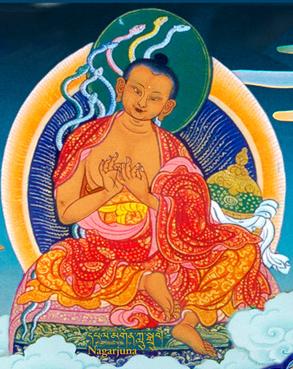Nagarjuna
Madhyamika (Skt. Mādhyamika;
Tib. དབུ་མ་པ་, umapa; Wyl. dbu ma pa) — the followers
of the Middle Way philosophy, which teaches freedom from all
extremes. They say that just as truly existent external phenomena were refuted
by the Chittamatra school, a truly existent
perceiving mind must also be refuted, since both are equally lacking in
inherent existence, being mere dependent originations.
中觀派(行者) (梵文Mādhyamika;藏文དབུ་མ་པ་,音譯「鄔瑪巴」umapa; 威利拼音dbu ma pa) —奉持中觀哲理的行者,教義為離於一切邊見。其指出,如同唯識宗駁斥有所謂真實存在的所知外境,能知實存之心亦不可得,因兩者皆不過是相依緣起,了無本有的實存。
The Madhyamika school originates
with Nagarjuna, who commented upon the direct meaning
of the Prajñaparamita sutras in his Collection of
Reasoning, which includes the famous Root Verses on the Middle Way.
中觀派由龍樹尊者所立,在其《正理聚》[1](Collection of Reasoning,龍樹六論集結)中論述了《般若波羅蜜多》經典的了義,並收錄了著名的《中觀根本慧論》[2](Root Verses on
the Middle Way)。
|
Contents內容
|
Subschools
These two approaches came about when two
Indian masters wrote slightly different commentaries to Nagarjuna’s Root
Verses text.
§ the followers of Madhyamika should not
make any independent assertions, but merely show the absurd consequences of
holding to any extreme position. This approach is called prasangika,
meaning “consequence”.
§ The other, Bhavaviveka, thought it was acceptable to use what
is called “autonomous syllogism” (svatantra). This approach is
called svatantrika.
分派
由於佛護論師(Buddhapalita)和清辨論師(Bhavaviveka)這兩位印度大師在解說龍樹尊者《中觀根本慧論》時略有異趣,自此中觀派便分為兩個「學派」(分支):自續派(自立量,Svatantrika)與應成派(隨應破,Prasangika)。
Madhyamika or Madhyamaka?
There has been some disagreement in
Western scholarship on the use of the terms Madhyamaka and Madhyamika. Great
Sanskritists such as T. R. V. Murti, a member of the Sanskrit Commission set
up by the Indian government in 1959, advocated the use of
"Madhyamika" on all occasions. Others use Madhyamaka for the system and the texts, and
Madhyamika for its advocates.
中觀派行者(Madhyamika)或中觀派(Madhyamaka)?
西方學界對Madhyamaka和Madhyamika這兩個語詞的使用時機,看法稍有歧義。有幾位大梵文學家,例如印度政府於1959年所成立梵文委員會(Sanskrit Commission)的成員之一——穆帝(T. R. V. Murti)便宣揚,皆以Madhyamika通稱即可。其他學者則在論述宗派或文典時使用「中觀派」(Madhyamaka),講到擁護者時使用「中觀派行者」(Madhyamika)。
Further Reading
§ David Seyfort Ruegg, The
Literature of the Madhyamaka School of Philosophy in India, Wiesbaden:
Harrassowitz, 1981
§ Kangyur
Rinpoche, Treasury of Precious Qualities (Boston & London:
Shambhala, 2001), 'Appendix 8'.
延伸閱讀
§
大衛.塞福特.魯格,《印度中觀派文獻》,德國威斯巴登:哈拉索維茨出版社,1981
§
甘珠爾仁波切(康居仁波切),《殊勝功德藏》,波士頓、倫敦:香巴拉出版社,2001,附錄8[3]
Internal links
內部連結
The four great logical
arguments of the Middle Way (Tib.
དབུ་མའི་གཏན་ཚིགས་ཆེན་པོ་བཞི་, Wyl. dbu
ma'i gtan tshigs chen po bzhi) are:
1.
The investigation of the cause:
the Diamond Splinters
2.
The investigation of the result:
refuting existent or non-existent results
3.
The investigation of the
essential identity: ‘neither one nor many’
4.
The investigation of all: the
Great Interdependence
External links
外部連結
分類:關鍵詞 | 學派和傳承 | 義理 | 中觀
~敬請參閱:
www.books.com.tw
› 中文書 › 宗教命理 › 佛教 › 生活佛法
2012年1月10日 - 堪布竹清嘉措仁波切是舉世公認當今世代最高成就的佛教學者與禪修大師之一。(Khenpo Tsültrim Gyamtso, The Sun of Wisdom)
~普賢法譯小組(Samantabhadra Translating Group)Wanchen 2014.01.28翻譯 / Hueyyun 2014.11.30一校,Serena 2015.02.04貼網,若有指正或建議請來信:sstc.roc@gmail.com 。願一切有情速入佛道、速證佛果!
[3] 譯註:中譯本《功德藏釋:三道甘露精華 經部上冊》已出版(Treasury of precious qualities : a commentary on the
root text of Jigme Lingpa),譯者劉婉俐,靈鷲山出版社,2015/01/01。
[4] 譯註:「智悲佛網」有言:「於因觀察,金剛屑因;於果觀察,破有無生因;於體觀察,離一多因;於一切觀察,大緣起因。中觀以四大因抉擇萬法。」(http://www.zhibeifw.com/wap/r.php?id=4860&t=1
英文版:麥彭仁波切《中觀四大理論》)

沒有留言:
張貼留言